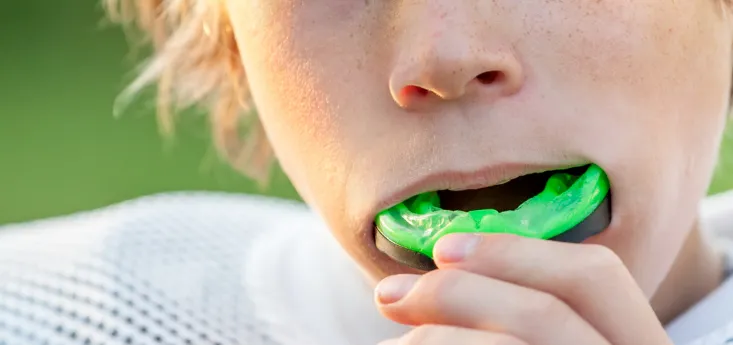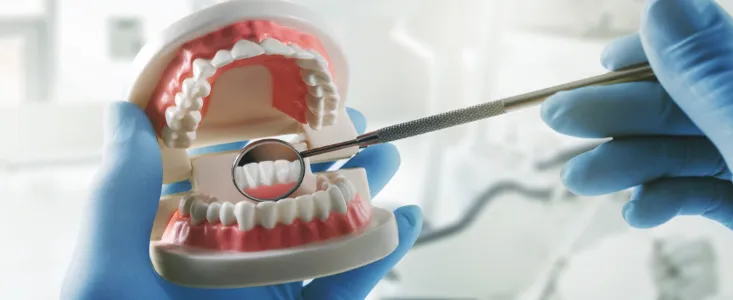Gum disease, or periodontitis, is an infection of the gums that can lead to the destruction of bones that support your teeth. Periodontitis is sneaky and, if left untreated, can lead to tooth loss. However, it is largely preventable and treatable! You just need to know what to look out for so that you can address it before it does too much damage.
Symptoms of Gum Disease
Healthy gums are pale pink in color, are firm to the touch, and fit snugly around your teeth.
Signs of gum disease include:
- Puffy, swollen gums
- Gums are bright red or purple in color
- Gums that are tender to the touch
- Gums that bleed easily
- A pink-tinged toothbrush after brushing your teeth
- Spitting out blood after brushing or flossing
- Bad breath
- Adults that have a loose tooth
- Chewing is painful
- Gums are receding and pulling away from the teeth
- Spaces develop between the teeth
- A change in your bite
Causes of Gum Disease
The majority of the time, periodontitis develops because of plaque buildup. Plaque is a sticky film made from bacteria. If plaque is not treated effectively, it can cause gum disease through this process:
- Plaque forms on your teeth: Plaque develops when starches and sugars mix with the bacteria that naturally form in your mouth. Plaque is removed every time you brush and floss your teeth. However, it doesn’t stay away for long! This is why we encourage you to brush your teeth twice a day and floss once a day.
- Plaque can turn into tartar: If plaque is not adequately removed, it can harden under your gumline. Tartar is filled with bacteria and is difficult to remove. Tartar that is ignored can lead to more damage. This is why you need to schedule regular dental appointments. Tartar can only be removed by a professional dental cleaning.
- Plaque can lead to gingivitis: Gingivitis is the mildest form of gum disease. This is diagnosed when the gum tissue at the base of your teeth is inflamed and irritated. With the help of professional dental treatment and good oral home care, gingivitis can be reversed.
- Continual gum inflammation leads to periodontitis: If gum inflammation continues to go unaddressed, pockets will develop between your teeth and easily fill up with bacteria, plaque, and tartar. Over time, the pockets become deeper, and the spaces are filled with more bacteria. These deep infections can lead to the loss of tissue and bone, and eventually the loss of one or more teeth.
How to Prevent Gum Disease
Like we mentioned in the beginning, gum disease is easily preventable. From an early age, it’s important to practice good oral hygiene and keep regular dentist appointments.
- Good Oral Hygiene: This includes brushing your teeth for at least two minutes a day, twice a day. Flossing once a day—especially before you brush—helps remove loosened food particles and bacteria that can easily cause plaque.
- Regular Dental Visits: We recommend scheduling a cleaning every six months to remove plaque and tartar and address any problem areas or issues like gingivitis before it turns into periodontitis.
Contact Atkins & Anderson, DDS today to schedule a cleaning for the whole family. Let’s address all the common issues like plaque and tartar before it develops into gum disease. If you currently have concerns about your gums, don’t wait another day to make an appointment.
Share
Summer vacation – a time to travel, have fun, and make memories! But when you leave on vacation, don’t forget to take your oral hygiene with you. Follow these tips from Atkins & Anderson DDS to keep your smile bright and healthy, even when you’re on vacation! 1. Schedule a Dental Checkup Before Your Trip
Summer is a time for vacations, family gatherings, and outdoor activities. It’s easy to forget about maintaining oral health during this fun and relaxing season. Here are six simple ways to protect your smile and keep your teeth healthy and strong during the summer. 1. Stay Hydrated Hydration is essential to maintaining good oral health.
How Does Oral Health Affect Overall Health? Poor oral hygiene allows harmful bacteria in your mouth to grow, enter your bloodstream, and travel to other parts of your body. This spreading of bacteria can trigger inflammation and infections, leading to serious health issues. What Health Issues Result from Poor Oral Health? Recent research shows the
Do you grind your teeth when you’re sleeping? Do you suffer from chronic headaches or jaw pain from clenching your teeth? When left untreated, these conditions can cause chips and cracks in your teeth and other dental problems. Wearing a custom-made mouthguard at night helps reduce your teeth-grinding symptoms and improve your sleep. Keep reading





